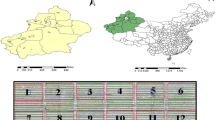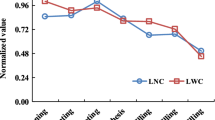Abstract
Analysis of the canopy structure change and spectral response mechanism of rice under flooding stress is an important prerequisite for large-scale monitoring of rice flooding disasters. The leaf area index (LAI) was used as the characterization indicator. The response rule of the canopy spectrum to flooding stress intensity was analyzed. The sensitive spectral characteristic parameters were screened to construct the LAI spectral response model of rice under flooding stress. The results showed that the rice LAI under flooding stress decreased with an increase in waterlogging depth. The spectral reflectance of the rice canopy under flooding stress significantly changed in the near-infrared band and decreased with an increase in waterlogging depth. In 680–760 nm, the double peak in the first-order differential spectrum of the rice canopy was more obvious with advancement of the growth process and a multiple peak appeared during the late growth stage. The blueshift of the red edge parameters was the most obvious in the submerged top during the tillering stage. A power function regression model based on the ratio of the first-order differential spectral amplitude at 737 nm to 719 nm in the red edge range was the optimal LAI response model for rice under flooding stress. A field waterlogging experiment was used to simulate and analyze the influence of flooding on the rice canopy structure and the canopy spectral response rule, providing a reference for the subsequent analysis of rice growth and disaster loss assessment under flooding stress.






Similar content being viewed by others
References
Anandan A, Pradhan SK, Das SK, Behera L, Sangeetha G (2014) Differential responses of rice genotypes and physiological mechanism under prolonged deepwater flooding. Field Crops Res 172:153–163
Aziz KA, Masaaki S, Muhammad Z, Safdar BM, Khalid N, Inayatullah A (2005) Effect of seedling age and water depth on morphological and physiological aspects of transplanted rice under high temperature. J Zhejiang Univ Sci 6B(5):389–395
Chen H, Liang Q, Liang Z, Liu Y, Xie S (2019) Remote-sensing disturbance detection index to identify spatio-temporal varying flood impact on crop production. Agric For Meteorol 269–270:180–191
Cho MA, Skidmore AK (2006) A new technique for extracting the red edge position from hyperspectral data: the linear extrapolation method. Remote Sens Environ 101(2):181–193
Chunyan H, Dengwei W, Yuxing Z (2009) Estimation of cotton canopy chlorophyll density and leaf area index based on red-edge parameters. Trans Chin Soc Agric Eng 25:137–141
Cloutis EA (1996) Review article: hyperspectral geological remote sensing: evaluation of analytical techniques. Int J Remote Sens 17(12):2215–2242
Das KK, Panda D, Sarkar RK, Reddy JN, Ismail AM (2009) Submergence tolerance in relation to variable floodwater conditions in rice. Environ Exp Bot 66(3):425–434
Demetriades-Shah TH, Steven MD, Clark JA (1990) High resolution derivative spectra in remote sensing. Remote Sens Environ 33(1):55–64
Ella ES, Ismail AM (2006) Seedling nutrient status before submergence affects survival after submergence in rice. Crop Sci 46(4):1673–1681
Filella I, Penuelas J (1994) The red edge position and shape as indicators of plant chlorophyll content, biomass and hydric status. Int J Remote Sens 15(7):1459–1470
Fukao T, Yeung E, Bailey-Serres J (2011) The submergence tolerance regulator sub1a mediates crosstalk between submergence and drought tolerance in rice. Plant Cell 23(1):412–427
Ganji Z, Shokoohi A, Samani JMV (2012) Developing an agricultural flood loss estimation function (case study: rice). Nat Hazards 64(1):405–419
Gautam P, Lal B, Raja R, Tripathi R, Shahid M, Baig MJ, Puree C, Mohanty S, Nayak AK (2015) Effect of simulated flash flooding on rice and its recovery after flooding with nutrient management strategies. Ecol Eng 77:250–256
Huang Z, Turner BJ, Dury SJ, Wallis IR, Foley WJ (2004) Estimating foliage nitrogen concentration from hymap data using continuum removal analysis. Remote Sens Environ 93(1–2):18–29
Jackson MB, Ram PC (2003) Physiological and molecular basis of susceptibility and tolerance of rice plants to complete submergence. Ann Bot 91:227–241
Jinhua N, Kuidong L, Zhiguo H, Na X, Wanhua H (2014) Effects of waterlogging stress on rice morphology and yield component at the jointing stage. Chin J Ecol 33(7):1818–1825
Ju CH, Tian YC, Yao X, Cao WX, Zhu Y, Hannaway D (2010) Estimating leaf chlorophyll content using red edge parameters. Pedosphere 20(5):633–644
Kuanar SR, Ray A, Sethi SK, Chattopadhyay K, Sarkar RK (2017) Physiological basis of stagnant flooding tolerance in rice. Rice Sci 24(2):73–84
Leroux L, Castets M, Baron M, Escorihuela MJ, Bégué A, Seen DL (2019) Maize yield estimation in West Africa from crop process-induced combinations of multi-domain remote sensing indices. Eur J Agron 108:11–26
Loreti E, Veen HV, Perata P (2016) Plant responses to flooding stress. Curr Opin Plant Biol 33:64–71
Mittler R, Vanderauwera S, Gollery M, Breusegem FV (2004) Reactive oxygen gene network of plants. Trends Plant Sci 9(10):490–498
Moshou D, Bravo C, Oberti R, West J, Bodria L, McCartney A, Ramon H (2005) Plant disease detection based on data fusion of hyper-spectral and multi-spectral fluorescence imaging using kohonen maps. Real-Time Imaging 11(2):75–83
Nishiuchi S, Yamauchi T, Takahashi H, Kotula L, Nakazono M (2012) Mechanisms for coping with submergence and waterlogging in rice. Rice 5(1):2
Reddy MD, Mittra BN (1985) Effect of complete plant submergence at different growth stages on grain yield, yield components and nutrient content of rice. Plant Soil 86(3):379–386
Sheikh KH (1973) Effects of flooding and drainage and their alternation on the growth and uptake of nutrients by rice (Oryza sativa L., indica, var. IR-8). J Exp Bot 24(1):64–75
Sianturia R, Jettena VG, Sartohadib J (2018) Mapping cropping patterns in irrigated rice fields in West Java: towards mapping vulnerability to flooding using time-series MODIS imageries. Int J Appl Earth Obs Geoinf 66:1–13
Sims DA, Gamon JA (2002) Relationships between leaf pigment content and spectral reflectance across a wide range of aperies, leaf structures and developmental stages. Remote Sens Environ 81(2):337–354
Toureiro T, Serralheiro R, Shahidian S, Sousa A (2017) Irrigation management with remote sensing: evaluating irrigation requirement for maize under Mediterranean climate condition. Agric Water Manag 184:211–220
Tsai F, Philpot W (1998) Derivative analysis of hyperspectral data. Remote Sens Environ 66(1):41–51
Turpie KR (2013) Explaining the spectral red-edge features of inundated marsh vegetation. J Coast Res 290:1111–1117
Vane G, Goetz AFH (1993) Terrestrial imaging spectrometry: current status, future trends. Remote Sens Environ 44(2–3):117–126
Yang J, Huo Z, Wu L, Wang T, Zhang G (2016) Indicator-based evaluation of spatiotemporal characteristics of rice flood in Southwest China. Agric Ecosyst Environ 230:221–230
Yanlin T, Renchao W, Jingfeng H (2004) Relations between red edge characteristics and agronomic parameters of crops. Pedosphere 14(4):467–474
Yordanova RY, Christov KN, Popova LP (2004) Antioxidative enzymes in barley plants subjected to soil flooding. Environ Exp Bot 51(2):93–101
Zhou J, Khot LR, Bahlol HY, Boydston R, Miklas PN (2016) Evaluation of ground, proximal and aerial remote sensing technologies for crop stress monitoring. Int Fed Autom Control 49(16):22–26
Funding
Funding was provided by The National Natural Science Foundation of China (Grant Nos. 41571323, 41501481); The National Natural Science Fund of Beijing (Grant No. 6172011); The Special Capacity Building for Innovation of Beijing Academy of Agriculture and Forestry Sciences (Grant No. KJCX20170705).
Author information
Authors and Affiliations
Corresponding author
Rights and permissions
About this article
Cite this article
Sun, Q., Gu, X., Sun, L. et al. Dynamic change in rice leaf area index and spectral response under flooding stress. Paddy Water Environ 18, 223–233 (2020). https://doi.org/10.1007/s10333-019-00776-5
Received:
Revised:
Accepted:
Published:
Issue Date:
DOI: https://doi.org/10.1007/s10333-019-00776-5




